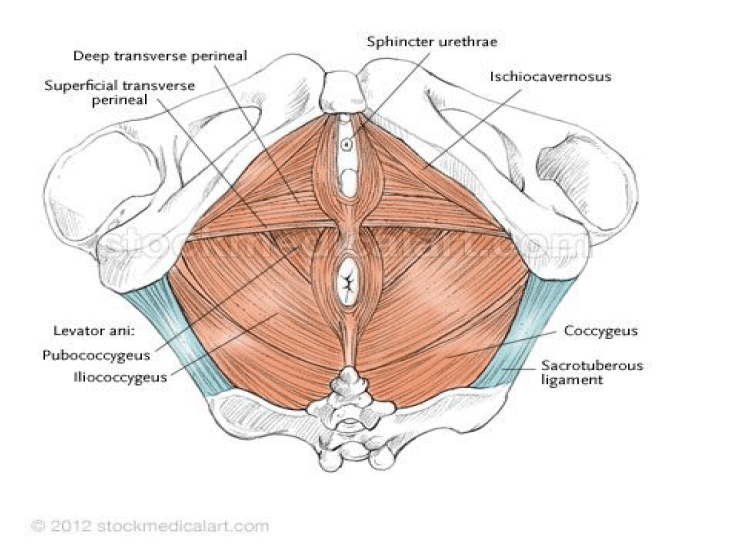If there were any taboo subject related to chronic pain, it would have to be in regards to pelvic health. Many clients (both women and men) have a difficult time bringing up pelvic floor issues as they are often regarded as embarrassing or irrelevant. The fact of the matter is millions of American’s are affected by pelvic floor dysfunction. One recent study found that up to 50% of women will experience pelvic dysfunction at some time in their life [1]. Men are no exception. A study in 2008 found that of 4,290 men interviewed, 18% reported some form of pelvic pain which significantly limited their lifestyle [2].

Figure 1. The muscles of the pelvic floor
Pelvic floor dysfunction is a broad term that involves muscular imbalances or dysfunction of pelvic joints that cause an array of symptoms. The muscles of the pelvic floor have a very important job; they assist in urinary and fecal continence, sexual performance, stabilization of the pelvic joints, and support the urogenital organs. If there is a muscle imbalance in the pelvic floor, it’s possible for any of these vital functions to be affected. The symptoms of pelvic floor dysfunction may include: pain in hip or buttock, painful lower abdomen, urinary incontinence, pain with sexual intercourse, or pain in pelvic joints. Given the intimate nature of these symptoms, many people only seek treatment after symptoms are nearly unbearable or full fledged. The good news is that there is hope for people struggling with pelvic floor dysfunction and associated pain symptoms.
How Can Northern Edge Physical Therapy Help
Northern Edge Physical Therapy understands the challenges faced by those suffering with pelvic floor dysfunction. Our physical therapists have sought additional training in pelvic health to identify the underlying source of the pain and offer a thorough plan to restore proper muscular balance of the pelvic floor muscles. At Northern Edge Physical Therapy we utilize proven technology such as rehabilitative ultrasound imaging and EMG biofeedback to retrain activation of the abdominal and pelvic floor musculature [3]. In addition, we use techniques such as dry needling and manual therapy to eliminate painful trigger points and restore tissue nutrition to allow the body to heal itself [4].
As part of our comprehensive approach, we also offer a revolutionary exercise system, known as Redcord. The Redcord system allows for low impact, suspension-based re-training of myofascial chains which include the pelvic floor muscles. Recent research has shown that the Redcord is an an invaluable tool for stabilizing the pelvic girdle [5,6].
Pelvic dysfunction may be an uncomfortable topic, but we offer hope at Northern Edge Physical Therapy.
Research
1. Sran, M., Mercier, J., Wilson, P., Lieblich, P., & Dumoulin, C. (2016). Physical therapy for urinary incontinence in postmenopausal women with osteoporosis or low bone density. Menopause, 23(3), 286-293. doi:10.1097/gme.0000000000000594
2. Pitts et al. Prevalence and Correlates of Three Types of Pelvic Pain in a Nationally Representative Sample of Australian Men. Journal of Sexual Medicine 2008; 5: 1223-1229.
3. Chmielewska, D., Stania, M., Sobota, G., Kwaśna, K., Błaszczak, E., Taradaj, J., & Juras, G. (2015). Impact of Different Body Positions on Bioelectrical Activity of the Pelvic Floor Muscles in Nulliparous Continent Women. BioMed Research International, 2015, 1-9. doi:10.1155/2015/905897
4. Moldwin, R. M., & Fariello, J. Y. (2013). Myofascial Trigger Points of the Pelvic Floor: Associations with Urological Pain Syndromes and Treatment Strategies Including Injection Therapy. Current Urology Reports, 14(5), 409-417. doi:10.1007/s11934-013-0360-7
5. The Efficacy of a Treatment Program Focusing on Specific Stabilizing Exercises for Pelvic Girdle Pain After Pregnancy. A Randomized Controlled Trial.
6. The Efficacy of a Treatment Program Focusing on Specific Stabilizing Exercises for Pelvic Girdle Pain After Pregnancy. A Two-Year Follow-up of a Randomized Clinical Trial.


0 Comments